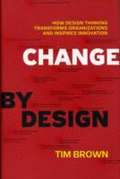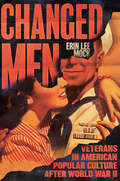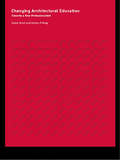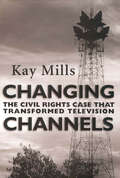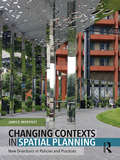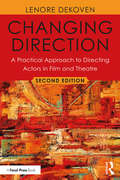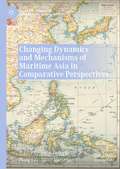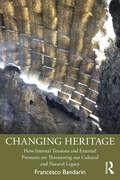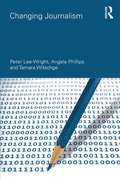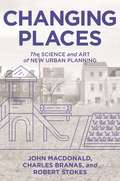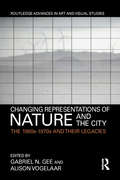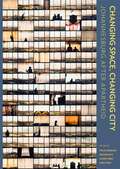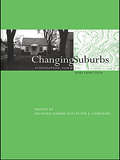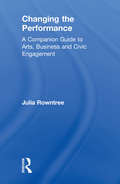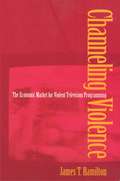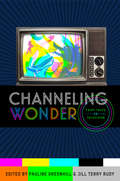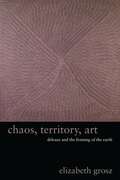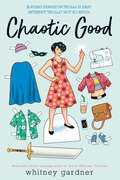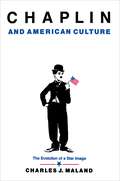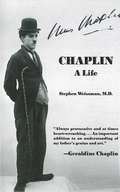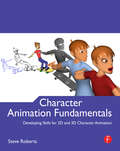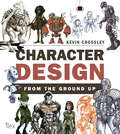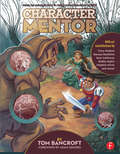- Table View
- List View
Change by Design: How Design Thinking Transforms Organizations and Inspires Innovation
by Tim BrownThe myth of innovation is that brilliant ideas leap fully formed from the minds of geniuses. In reality, most innovations are borne from rigor and discipline.
Changed Men: Veterans in American Popular Culture after World War II (Cultural Frames, Framing Culture)
by Erin Lee MockPostwar culture and anxiety over the reintegration of veterans into American society Millions of GIs returned from overseas in 1945. A generation of men who had left their families and had learned to kill and to quickly dispatch sexual urges were rapidly reintegrated into civilian life, told to put the war behind them with cheer and confidence. Many veterans struggled, openly or privately, with this transition. Others in society wondered what the war had wrought in them. As Erin Lee Mock shows in this insightful book, the &“explosive&” potential of men became a central concern of postwar American culture. This wariness of veterans settled into a generalized anxiety over men&’s &“inherent&” violence and hypersexuality, which increasingly came to define masculinity. Changed Men engages with studies of film, media, literature, and gender and sexuality to advance a new perspective on the artistic and cultural output of and about the &“Greatest Generation,&” arguing that depictions of men&’s violent and erotic potential emerged differently in different forms and genres but nonetheless permeated American culture in these years. Viewing this homecoming through the lenses of war and trauma, classical Hollywood, pulp fiction, periodical culture, and early television, Mock shows this history in a provocative new light.
Changing Architectural Education: Towards a New Professionalism
by XcbArchitectural education is under pressure to meet the demands of an evolving construction industry and to cater to the increasingly varied career destinations of graduates. How should architectural education respond to these professional challenges? How can students be better prepared for professional practice? These questions are the focus of this book, which brings together contributions from a wide range of authors, from both the UK and the USA, working in the fields of architectural education, architectural practice and educational research.
Changing Channels: The Civil Rights Case that Transformed Television
by Kay MillsIn the years before the civil rights era, American broadcasting reflected the interests of the white mainstream, especially in the South. Today, the face of local television throughout the nation mirrors the diversity of the local populations. The impetus for change began in 1964, when the Office of Communication of the United Church of Christ and two black Mississippians, Aaron Henry and Reverend R. L. T. Smith, challenged the broadcasting license of WLBT, an NBC affiliate in Jackson, Mississippi. The lawsuit was the catalyst that would bring social reform to American broadcasting. This station in a city whose population was 40 percent black was charged with failure to give fair coverage to civil rights and to integration issues that were dominating the news. Among offenses cited by the black population were the cancellation of a network interview with the civil rights attorney Thurgood Marshall and editorializing against the integration of the University of Mississippi. However, muscle, money, and a powerhouse Washington, D.C., law firm were on the side of the station. Despite the charges, the Federal Communications Commission twice renewed the station's license. Twice the challengers won appeals to the federal courts. Warren Burger, then a federal appeals court judge, wrote decisions on both challenges. The first ordered the FCC to allow public participation in its proceedings. The second, an unprecedented move, took the license from WLBT. This well-told, deeply researched history of the case covers the legal battles over their more than fifteen years and reports the ultimate victory for civil rights. Aaron Henry, a black civil rights leader and one of the plaintiffs, became the station's chairman of the board. WLBT's new manager, William Dilday, was the first black person in the South to hold such a position. Burger's decision on this Mississippi case had widescale repercussions, for it allowed community groups in other regions to challenge their stations and to negotiate for improved services and for the employment of minorities.
Changing Contexts in Spatial Planning: New Directions in Policies and Practices
by Janice MorphetThis book considers the major forces that have emerged to reshape planning following 2010, including national infrastructure project delivery, the Localism Act (2011) and neighbourhood planning. This period also saw the introduction of the replacement of regional plans by new strategic sub-regional approaches in combined local authorities for functional economic areas. All of this is set within the UN’s New Urban Agenda, Brexit, the changing programme for the EU post 2021 and the likely effects that these will have on UK planning practice. There is also a discussion on the evolving planning policies in Scotland, Wales and Northern Ireland and the ways in which the UK nations are beginning to work together more closely and with Ireland, Jersey, Guernsey and the Isle of Man through the spatial planning group in the British–Irish Council. Although primarily focused on the UK, the text sets some of the policy discussions in a wider international context including agreements on the environment and the emerging alignment of governance and economies in newly recognised sub-regional spaces. It follows Effective Practice in Spatial Planning (2011), which addressed the developments in planning in the UK between 2004 and 2010, and discusses the major changes in all aspects of planning policy in the following period.
Changing Direction: Foreword by Ang Lee
by Lenore DeKovenThe second edition of this elegant and accessible primer offers a helpful reference and resource for directing actors in film, television, and theatre, useful to directors, actors, and writers. Combining underlying theory with dozens of exercises designed to reveal the actor's craft, Lenore DeKoven discusses constructing the throughline; analyzing the script; character needs; the casting and rehearsal processes; as well as the actor and the camera. Distilling difficult concepts to their simplest form, DeKoven explains how to accurately capture and portray human behavior on stage and screen, offering creative solutions to issues she has encountered or anticipated after decades of experience. Excerpts from interviews with acclaimed actors offer insight into their work with directors, what inspires them, and what they really want from the director. This second edition incorporates the film Moonlight (2016, Barry Jenkins) for analysis of the directing concepts discussed.
Changing Dynamics and Mechanisms of Maritime Asia in Comparative Perspectives (Palgrave Studies in Comparative Global History)
by Hong Liu Shigeru Akita Shiro MomokiThis book attempts to reveal historical dynamism of transforming contemporary Maritime Asia and to identify key driving forces or agencies for the evolution and transformation of Maritime Asia in the context of global history studies. It seeks to accomplish these goals by connecting different experiences in Maritime Asia both historically from the late early-modern to the present and spatially covering both East and Southeast Asia. Focusing on interactions on and through oceans, seas, and islands, Maritime Asia can deal with any aspects of human society and the nature, including diplomacy, maritime trade, cultural exchange, identity and others. Its interest in supra-regional interactions and networks, migration and diaspora, combined with its microscopic concern with local and trans-border affairs, will surely contribute to the common task of contemporary social sciences and humanities, to relativize the conventional framework based on the nation-state. In this regard, research in Maritime Asia claims to be an integral part of global studies. Part I deals with long-distance trade and diplomatic relations during the late early modern era and its transition to the modern era, mainly in the nineteenth century. Part II focuses on the emergence of transregional and trans-oceanic Asian networks and the original institution-building efforts in the Asia-Pacific region in the twentieth century.
Changing Heritage: How Internal Tensions and External Pressures are Threatening Our Cultural and Natural Legacy
by Francesco BandarinChanging Heritage presents the most comprehensive analysis of heritage issues available today. Critically analysing the complexity of the current and forthcoming issues faced by heritage, it presents insightful directions for the future.Drawing on the author’s many years of experience working in senior positions at UNESCO, the book presents discussions of heritage sites all around the world. Today, our cultural and natural legacies face significant threats due to social and economic developments, political pressures, and unresolved historical issues. This book delves into these threats from two distinct perspectives: internal tensions and external pressures. The internal tensions include the disregard for human rights and gender equality; the increasing exploitation of heritage for political purposes; the development of post-colonial perspectives; and the necessity to reassess the established notion of "universal value." External pressures stem from global processes, unsustainable tourism, political conflicts, ethnic clashes, and religious strife that are causing destruction in numerous parts of the world. Examining the dynamics between heritage and these internal tensions and external pressures, Bandarin offers insights into the challenges faced and emphasises the imperative role of civil society in safeguarding the value of heritage for present and future generations.Changing Heritage explores a wide range of issues surrounding the crisis in heritage management on an international level. It will be essential reading for heritage scholars, students, and professionals
Changing Journalism (Communication and Society)
by Tamara Witschge Angela Phillips Peter Lee-WrightJournalism is in transition. Irrevocable decisions are being made, often based on flimsy evidence, which could change not only the future of journalism, but also the future of democracy. This book, based on extensive research, provides the opportunity to reflect upon these decisions and considers how journalism could change for the better and for the good of democracy. It covers: the business landscape work and employment the regulatory framework audiences and interaction the impact of technology on practices and content ethics in a converged world The book analyses research in both national and local journalism, broadcast, newspaper and online journalism, broadsheet and tabloid, drawing comparisons between the different outlets in the field of news journalism, making this essential reading for scholars and students of journalism and media studies.
Changing Places: The Science and Art of New Urban Planning (Global Academic Publishing Ser.)
by John MacDonald Charles Branas Robert StokesHow the science of urban planning can make our cities healthier, safer, and more livableThe design of every aspect of the urban landscape—from streets and sidewalks to green spaces, mass transit, and housing—fundamentally influences the health and safety of the communities who live there. It can affect people's stress levels and determine whether they walk or drive, the quality of the air they breathe, and how free they are from crime. Changing Places provides a compelling look at the new science and art of urban planning, showing how scientists, planners, and citizens can work together to reshape city life in measurably positive ways.Drawing on the latest research in city planning, economics, criminology, public health, and other fields, Changing Places demonstrates how well-designed changes to place can significantly improve the well-being of large groups of people. The book argues that there is a disconnect between those who implement place-based changes, such as planners and developers, and the urban scientists who are now able to rigorously evaluate these changes through testing and experimentation. This compelling book covers a broad range of structural interventions, such as building and housing, land and open space, transportation and street environments, and entertainment and recreation centers.Science shows we can enhance people's health and safety by changing neighborhoods block-by-block. Changing Places explains why planners and developers need to recognize the value of scientific testing, and why scientists need to embrace the indispensable know-how of planners and developers. This book reveals how these professionals, working together and with urban residents, can create place-based interventions that are simple, affordable, and scalable to entire cities.
Changing Representations of Nature and the City: The 1960s-1970s and their Legacies (Routledge Advances in Art and Visual Studies)
by Gabriel N. Gee Alison VogelaarThe turn of the 1960s-70s, characterized by the rapid acceleration of globalization, prompted a radical transformation in the perception of urban and natural environments. The urban revolution and related prospect of the total urbanisation of the planet, in concert with rapid population growth and resource exploitation, instigated a surge in environmental awareness and activism. One implication of this moment is a growing recognition of the integration and interconnection of natural and urban entities. The present collection is an interdisciplinary inquiry into the changing modes of representation of nature in the city beginning from the turn of the 1960s/70s. Bringing together a number of different disciplinary approaches, including architectural studies and aesthetics, heritage studies and economics, environmental science and communication, the collection reflects upon the changing perception of socio-natures in the context of increasing urban expansion and global interconnectedness as they are/were manifest in specific representations. Using cases studies from around the globe, the collection offers a historical and theoretical understanding of a paradigmatic shift whose material and symbolic legacies are still accompanying us in the early 21st century.
Changing Space, Changing City: Johannesburg after apartheid - Open Access selection
by Graeme Gotz Alison Todes Chris Wray Philip HarrisonAs the dynamo of South Africa’s economy, Johannesburg commands a central position in the nation’s imagination, and scholars throughout the world monitor the city as an exemplar of urbanity in the global South. This book offers detailed empirical analyses of changes in the city’s physical space, as well as a host of chapters on the character of specific neighbourhoods and the social identities being forged within them. Informing all of these is a consideration of underlying economic, social and political processes shaping the wider Gauteng province. A mix of respected academics, practising urban planners and experienced policymakers offer compelling overviews of the rapid and complex spatial developments that have taken place in Johannesburg since the end of apartheid, along with tantalising glimpses into life on the streets and behind the high walls of this diverse city. The book has three sections. Section A provides an overview of macro spatial trends and the policies that have influenced them. Section B explores the shaping of the city at district and suburban level, revealing the peculiarity of processes in different areas. This analysis elucidates the larger trends, while identifying shifts that are not easily detected at the macro level. Section C is an assembly of chapters and short vignettes that focus on the interweaving of place and identity at a micro level.With empirical data supported by new data sets including the 2011 Census, the city’s Development Planning and Urban Management Department’s information system, and Gauteng City-Region Observatory’s substantial archive, the book is an essential reference for planning practitioners, urban geographers, sociologists, and social anthropologists, among others.
Changing Suburbs: Foundation, Form and Function
by Richard Harris Peter LarkhamThe editors and contributors to this volume demonstrate how suburbs and the meaning of suburbanism change both with time and geographical location.Here the disciplines of history, geography and sociology, together with subdisciplines as diverse as gender studies, art history and urban morphology, are brought together to reveal the nature of suburbia from the nineteenth century to the present day.
Changing the Performance: A Companion Guide to Arts, Business and Civic Engagement
by Julia RowntreeA result of many years of research and practice, Changing the Performance is a book about the arts and about business, and the interplay between the two. Julia Rowntree gives a fascinating account of her experiences forging the business sponsorship campaign at the London International Festival of Theatre (LIFT). Raising intriguing questions, this book proposes that fundraising for the arts is much more than simply a function for generating income. It fulfils an ancient social role of connection across levels of power, expertise, culture, gender and generation. Rowntree describes why these dynamics are vital to society's ability to adapt. Changing the Performance is an inspiring manual for arts practitioners concerned with the relationship between business, the arts and wider society, and particularly those engaged in fundraising.
Channeling Violence: The Economic Market for Violent Television Programming
by James T. Hamilton"If it bleeds, it leads." The phrase captures television news directors' famed preference for opening newscasts with the most violent stories they can find. And what is true for news is often true for entertainment programming, where violence is used as a product to attract both viewers and sponsors. In this book, James Hamilton presents the first major theoretical and empirical examination of the market for television violence. Hamilton approaches television violence in the same way that other economists approach the problem of pollution: that is, as an example of market failure. He argues that television violence, like pollution, generates negative externalities, defined as costs borne by others than those involved in the production activity. Broadcasters seeking to attract viewers may not fully bear the costs to society of their violent programming, if those costs include such factors as increased levels of aggression and crime in society. Hamilton goes on to say that the comparison to pollution remains relevant when considering how to deal with the problem. Approaches devised to control violent programming, such as restricting it to certain times and rating programs according to the violence they contain, have parallels in zoning and education policies designed to protect the environment. Hamilton examines in detail the microstructure of incentives that operate at every level of television broadcasting, from programming and advertising to viewer behavior, so that remedies can be devised to reduce violent programming without restricting broadcasters' right to compete.
Channeling Wonder: Fairy Tales on Television
by Pauline Greenhill Jill Terry RudyTelevision has long been a familiar vehicle for fairy tales and is, in some ways, an ideal medium for the genre. Both more mundane and more wondrous than cinema, TV magically captures sounds and images that float through the air to bring them into homes, schools, and workplaces. Even apparently realistic forms, like the nightly news, routinely employ discourses of "once upon a time," "happily ever after," and "a Cinderella story." In Channeling Wonder: Fairy Tales on Television, Pauline Greenhill and Jill Terry Rudy offer contributions that invite readers to consider what happens when fairy tale, a narrative genre that revels in variation, joins the flow of television experience. Looking in detail at programs from Canada, France, Italy, Japan, the UK, and the U.S., this volume's twenty-three international contributors demonstrate the wide range of fairy tales that make their way into televisual forms. The writers look at fairy-tale adaptations in musicals like Rodgers and Hammerstein's Cinderella, anthologies like Jim Henson's The Storyteller, made-for-TV movies like Snow White: A Tale of Terror, Bluebeard, and the Red Riding Trilogy, and drama serials like Grimm and Once Upon a Time. Contributors also explore more unexpected representations in the Carosello commercial series, the children's show Super Why!, the anime series Revolutionary Girl Utena, and the live-action dramas Train Man and Rich Man Poor Woman. In addition, they consider how elements from familiar tales, including "Hansel and Gretel," "Little Red Riding Hood," "Beauty and the Beast," "Snow White," and "Cinderella" appear in the long arc serials Merlin, Buffy the Vampire Slayer, and Dollhouse, and in a range of television formats including variety shows, situation comedies, and reality TV. Channeling Wonder demonstrates that fairy tales remain ubiquitous on TV, allowing for variations but still resonating with the wonder tale's familiarity. Scholars of cultural studies, fairy-tale studies, folklore, and television studies will enjoy this first-of-its-kind volume.
Chaos, Territory, Art: Deleuze and the Framing of the Earth (The Wellek Library Lectures)
by Elizabeth GroszInstead of treating art as a unique creation that requires reason and refined taste to appreciate, Elizabeth Grosz argues that art-especially architecture, music, and painting-is born from the disruptive forces of sexual selection. She approaches art as a form of erotic expression connecting sensory richness with primal desire, and in doing so, finds that the meaning of art comes from the intensities and sensations it inspires, not just its intention and aesthetic.By regarding our most cultured human accomplishments as the result of the excessive, nonfunctional forces of sexual attraction and seduction, Grosz encourages us to see art as a kind of bodily enhancement or mode of sensation enabling living bodies to experience and transform the universe. Art can be understood as a way for bodies to augment themselves and their capacity for perception and affection-a way to grow and evolve through sensation. Through this framework, which knits together the theories of Charles Darwin, Henri Bergson, Gilles Deleuze, Félix Guattari, and Jakob von Uexküll, we are able to grasp art's deep animal lineage. Grosz argues that art is not tied to the predictable and known but to new futures not contained in the present. Its animal affiliations ensure that art is intensely political and charged with the creation of new worlds and new forms of living. According to Grosz, art is the way in which life experiments with materiality, or nature, in order to bring about change.
Chaotic Good
by Whitney GardnerCosplay, comic shops, and college applications collide in this illustrated novel, perfect for fans of Adam Silvera and Noelle Steveson!Cameron's cosplay creations are finally starting to earn her attention--attention she hopes to use to get into the CalArts costume design department for college. But after she wins a major competition, she inadvertently sets off a firestorm of angry comments from male fans online.When Cameron's family moves the summer before her senior year, she hopes to complete her costume portfolio in peace and quiet away from the abuse.Unfortunately, the only comic shop in town--her main destination for character reference--is staffed by a dudebro owner who challenges every woman who comes into the shop. At her twin brother's suggestion, Cameron borrows a set of his clothes and uses her costuming expertise to waltz into the shop as Boy Cameron, where she's shocked at how easily she's accepted into the nerd inner sanctum. Soon, Cameron finds herself drafted into a D&D campaign alongside the jerky shop-owner Brody, friendly (almost flirtatiously so) clerk Wyatt, handsome Lincoln, and her brother Cooper, dragged along for good measure. But as her "secret identity" gets more and more entrenched, Cameron's portfolio falls by the wayside--and her feelings for Lincoln threaten to make a complicated situation even more precarious in this geek girl anthem from You're Welcome, Universe author Whitney Gardner, complete with fully illustrated comic pages inked by Gardner herself.
Chaplin and American Culture: The Evolution of a Star Image
by Charles J. MalandCharles Maland focuses on the cultural sources of the on-and-off, love-hate affair between Chaplin and the American public that was perhaps the stormiest in American stardom.
Chaplin: A Life
by Stephen Weissman"Chaplin is arguably the single most important artist produced by the cinema," wrote film critic Andrew Sarris. Born in London in 1889, Charlie Chaplin grew up in dire poverty. Severe alcoholism cut short his father's flourishing career, and his beloved mother first lost her voice, then her mind, to syphilis. How did this poor, lonely child, committed to the Hanwell School for the Orphaned and Destitute, become such an extraordinary comedian, known and celebrated worldwide? Dr. Stephen M. Weissman brilliantly illuminates both the screen legend himself and the turbulent era that shaped him.
Character Animation Fundamentals: Developing Skills for 2D and 3D Character Animation
by Steve RobertsExpand your animation toolkit and remain competitive in the industry with this leading resource for 2D and 3D character animation techniques. Apply the industry's best practices to your own workflows and develop 2D, 3D and hybrid characters with ease. With side by side comparisons of 2D and 3D character design, improve your character animation and master traditional principles and processes including weight and balance, timing and walks. Develop characters inspired by humans, birds, fish, snakes and four legged animals. Breathe life into your character and develop a characters personality with chapters on acting, voice-synching and facial expressions. Expertly integrate core animation techniques with your software of choice featuring step-by-step tutorials, highlighting 3ds Max, Maya and Blender workflows. Adapt the tips, tricks and techniques for unique projects like character design for rotoscoping and motion capture. Advance beyond the fundamentals of 2D and 3D character animation with the companion website which includes short demonstration movies, 2D and 3D exercises and fully rigged character models.
Character Costume Figure Drawing: Step-by-Step Drawing Methods for Theatre Costume Designers
by Tan HuaixiangCharacter Costume Figure Drawing is an essential guide that will improve your drawing skills and costume renderings. Step-by-step visuals illustrate the how-tos of drawing body parts, costumes, accessories, faces, children, and different character archetypes, such as maternal, elderly, sassy, sexy, and evil. By focusing on the foundations of drawing bodies, including body proportion, bone structure, body masses, facial expressions, and appendages, this guide shows you how to develop sketches from stick figures to full-blown characters. The third edition features a new chapter, Digital Mixed Media Costume Rendering. This chapter introduces the basic usages of Photoshop tools to enhance and improve costume designs, in order to provide easy delivery design ideas to the director and design team, provide easy changes and alterations during the design process, virtually apply actual fabric swatches over costume sketches, and help visualize lighting effects.
Character Design from the Ground Up: Make Your Sketches Come To Life
by Kevin CrossleyAll stories have characters, and whether its a film, game, book, or comic, all characters need to be designed. Character design has become a distinct discipline in the entertainment industry, and character designers are employed by film and game companies across the globe to bring life to scripts and ideas. In this book, illustrator and character designer Kevin Crossley provides a complete overview of character design. Starting with the basics of materials, equipment, and sofware, Kevin will explain the processes professional character designers follow to develop characters for publishing, games, and film. From ideas and thumbnails, anatomy and reference, through effective drawing, 3D mock-ups and full turnarounds, Kev explains how a character designer works to achieve professional results.
Character Design from the Ground Up: Make Your Sketches Come To Life
by Kevin CrossleyAll stories have characters, and whether its a film, game, book, or comic, all characters need to be designed. Character design has become a distinct discipline in the entertainment industry, and character designers are employed by film and game companies across the globe to bring life to scripts and ideas. In this book, illustrator and character designer Kevin Crossley provides a complete overview of character design. Starting with the basics of materials, equipment, and sofware, Kevin will explain the processes professional character designers follow to develop characters for publishing, games, and film. From ideas and thumbnails, anatomy and reference, through effective drawing, 3D mock-ups and full turnarounds, Kev explains how a character designer works to achieve professional results.
Character Mentor: Learn by Example to Use Expressions, Poses, and Staging to Bring Your Characters to Life
by Tom BancroftYou've researched your character extensively, tailored her to your audience, sketched hundreds of versions, and now you lean back content as you gaze at your final character model sheet. But now what? Whether you want to use her in an animated film, television show, video game, web comic, or children's book, you're going to have to make her perform. How a character looks and is costumed starts to tell her story, but her body language reveals even more. Character Mentor shows you how to pose your character, create emotion through facial expressions, and stage your character to create drama. Author Tom Bancroft addresses each topic with clear, concise prose, and then shows you what he really means through commenting on and redrawing artwork from a variety of student "apprentices." His assignments allow you to join in and bring your drawing to the next level with concrete techniques, as well as more theoretical analysis. Character Mentor is an apprenticeship in a book. Professional artists from a variety of media offer their experience through additional commentary. These include Marcus Hamilton (Dennis the Menace), Terry Dodson (X-Men), Bobby Rubio (Pixar), Sean "Cheeks" Galloway (Spiderman animated), and more. With a foreword by comicbook artist Adam Hughes, who has produced work for DC, Marvel Comics, Lucasfilm, Warner Bros. Pictures, and other companies.
